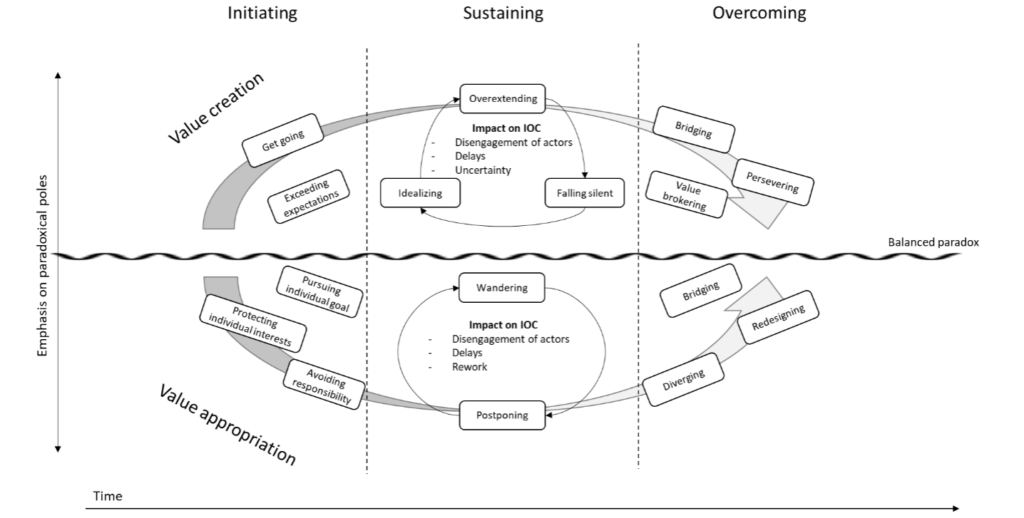Overcoming persistent challenges in organizing collaboration for the last mile
As actors engage in inter-organizational collaboration in last-mile contexts and try to organize and develop their value proposition, they are often faced with persistent challenges that hinder the collaboration moving forward. When these challenges aren’t dealt with appropriately, this can result in vicious cycles that turn the collaboration ineffective and not being able to address urgent societal issues in our inner cities. Hence, actors have to be able to break out of these cycles. In this study we compare two cases, Heyendaal and CareHub, showing how these challenges can evolve and persist over time, and how actors attempt to overcome them in order to move forward.
Context and relevance
As actors develop their collaborative efforts in organizing the last-mile, they have to balance competing demands which do not always align with each other. One of these competing demands lay between value creation, so collaborating in order to create value such as lower costs, less pollution or providing a higher quality service, and on the other hand value appropriation, which means extracting a part of this collective value for the individual organizations themselves. Actors have to navigate these tensions as they are two very different processes (e.g. collaborating vs. competing), and furthermore, this process has to be fair (e.g actors putting in a lot of work should deserve a bigger piece of the pie). When these processes are not balanced appropriately, this may result in cycles of persistent challenges that could turn the collaboration into a downwards spiral. Therefore, it is important that we gain a better understanding of how these cycles emerge and of course how actors can turn these situations into something positive again. As it is not just the collaboration potentially having to disband or to become ineffective, but also that it inhibits their ability to tackle the large issues we face in our cities.
Research question
From their inception in 2019, two cases have been followed to take an in-depth look at how these persistent challenges emerge and develop. Together, they aim to address the research question:
How do actors overcome persistent challenges while organizing collaboration for the last-mile?
Research approach
We have followed two cases, Heijendaal and CareHub, from their inception in late 2019 up until June 2022. The case of Heijendaal has already been introduced in earlier chapters. CareHub was a case where diverse public and private actors started out to design an integrated service of wellbeing, healthcare and goods delivery to elderly citizens in a Dutch Neighborhood. The two cases were polar opposites, one overemphasizing value creation and the other value appropriation, making them interesting cases to compare and contrast. Through the collection of interviews, observations and documents we have been able to follow their evolution over time. This enabled us to identify how these vicious cycles of persistent challenges were initiated, sustained and how actors attempted to overcome them. We specifically looked at the practices actors used on a day to day bases, either knowingly or unknowingly. Ultimately, this produced a model showing how the different scenarios unfolded.
Results
From our analysis we found that both an overemphasis of value creation and value appropriation could result in the initiation of a vicious cycle in the collaboration. We briefly go through the main findings.

At Heijendaal we identified how actors initiated a vicious cycle favoring value appropriation. We saw that actors pursuing individual goals, such as focusing on an organizations individual business case, or avoiding responsibility where no single actor took or had responsibility to make decisions for the IOC, could result in the initiation of a vicious cycle. This led to frustration and delays in project meetings as it remained difficult to look at the bigger picture and first focus on how to create a new service by adding suppliers and taking an integrated cost perspective. This resulted in passive behavior for an extended period of time during the next phase, where we identified practices such as wandering, when it was difficult for actors to link certain actions or sub projects to an overarching goal, and postponing where issues revolving costs or stakeholder engagement where postponed to next meetings as actors did not exactly know how to deal with it. Ultimately however, actors started to break out of this cycle. For example by bridging, where they started to connect the operational issues to the overarching goals again. Or by redesigning, where they introduced a more efficient meeting schedule or introduced a operational project team to become more effective. These practices allowed them to start focusing again on how to create value.
At CareHub we identified how actors overemphasized value creation. We analyzed how early success was fueled by actors having a tangible and common goal: the elderly citizen. Combined with a common background in the healthcare domain, the actors were able to quickly start experimenting and exceed expectations: combined deliveries were made and the service was renowned on a national level. However, financial value still had to be appropriated through a business case, which remained difficult and for now required on external funding. But as this success had the upper hand, it was difficult to diverge from this path. This resulted in practices such as overextending, where they dedicated their limited FTE capacity to further developing the service instead of focusing on the business case. Which tied into practices of idealizing, where the hope of the project remaining a success and guaranteeing external funding had a similar effect. However, the lack of a business case eventually resulted in a stop of external funding, leaving the collaboration unable to progress. To overcome this, actors started using bridging here as well in negotiations with the external funders, highlighting the elderly citizen as a tangible goal to work towards. Furthermore, they used value brokering practices, where they initiated various communications at different levels of the external funder to convince them of the need of this service. This allowed them to guarantee additional funding and construct a business case.
Conclusions, policy recommendations and directions for future research
Based on this study we can provide a number of conclusions and recommendations for practice:
- Although experimentation is useful and essential for developing novel services to address challenges in organizing the last mile, it is also necessary to work with concrete goals that provide structure and purpose to the actors in the collaboration. Also, the more tangible and shared the goals are, the easier it is for actors to collaborate. Find common ground from which actors can start off, and connect to throughout the collaboration.
- It is important for actors in these collaborations to become aware of the need to both collaborate to create novel value, as well as to compete to extract some sort of value for their individual organization. These processes go hand-in-hand. However, overemphasizing or ignoring either of the two processes will result in a negative effect on the collaboration that will not benefit anyone in the end. It is essential that these vicious cycles are mitigated during early stages of the collaboration as to not let the project spin out of control (see bullet 3).
- In line with the previous two bullet points, it is recommended to install a program manager with the mandate to make decisions for the different actors involved in the collaboration, as well as sufficient time to deal with both operational but especially strategic issues in these complex projects.
- We see that both the use of (seemingly) positive practices such as exceeding expectations or idealizing can result in the initiation and sustainment of a vicious cycle of persistent challenges, as well as the use of more defensive practices such as pursuing individual goals or postponing. Hence, actors can benefit from a reflexive mindset, where they become aware of both the positive collaborative practices they enact, but also the more defensive or competitive practices. This allows them to maintain a critical perspective on the collaboration which will inform their decision making.
- The research shows how both a single organization can initiate a vicious cycle of persistent challenges for the entire collaboration, for example through pursuing individual goals, but also that successful collaboration can result in a collection of actors to overlook/underemphasize to construct a business case due to ongoing success in creating a novel service, which can also lead to persistent challenges in the collaboration. This shows the interrelatedness and dependency of different actors in the collaboration, but also the need to collectively come up with solutions to move forward.
- From these two cases, as well as findings from prior research, it shows that the role of the municipality is of great importance in developing these collaborations. They can provide financial support, create favorable conditions in zoning inner cities and can take a birds-eye view/coordination role in order to bring actors together or structurally develop the collaboration together with private parties. Therefore, it is important that the municipality, and the concrete role of the municipality, is involved at early stages of the project.
